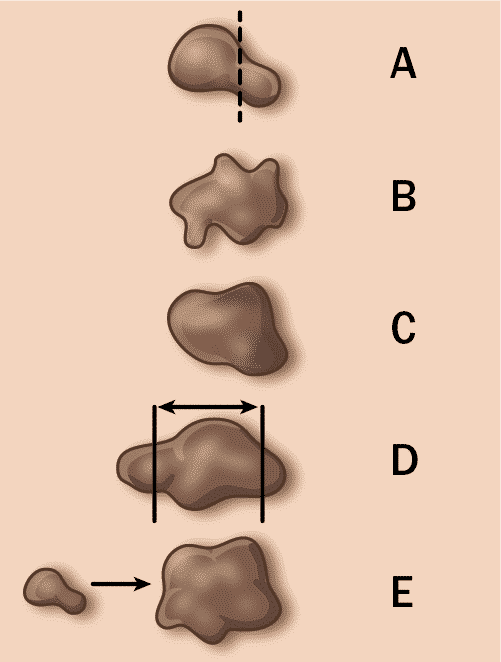Signs & Symptoms of Skin Cancer
A lesion on the skin of the face, neck, or scalp.
Skin cancer can present in a few different ways. Some cancers are very slow growing and slow changing; others change quickly. If a patient sees a new lesion on their body, they should have it evaluated by a dermatologist (skin doctor). Most lesions are not cancer, and most cancers of the skin are slow growing and easily treated. But because some lesions don’t fit into one of those categories, it is important to have them checked out. If something is growing quickly, don’t wait to have it evaluated.
“ABCDE”
The mnemonic “ABCDE” should be kept in mind for any type of skin lesion.

- Asymmetry
If a mole were divided in half, it would not be the same shape on both sides. - Border
The edges of the mole are jagged and uneven. - Color
A mole has several colors, or it gains or loses color. - Diameter
A mole is more than half a centimeter across at its greatest dimension. - Evolution
A skin lesion changes shape, color, size or texture.
Signs & Symptoms of Advanced Disease
An itchy and bleeding area.
Sometimes it might not be possible to see a lesion on the scalp. But if something is constantly bleeding or particularly itchy or painful, it’s worth having it checked out by a doctor.
A lump or bump in the neck or face.
In some cases, the first sign of a skin cancer might actually be a bump or lump in the neck or the face. This could represent a lymph node. Lymph nodes in the neck or a lump located in front of the ear in the parotid gland that turn out to be cancerous should raise the concern for a skin cancer that may have spread there.
Some people who are at an increased risk of getting skin cancer might not notice a lesion at all. These patients may choose to visit a dermatologist regularly for a skin evaluation, or screening. Patients who are immunocompromised should undergo routine skin screenings due to the increased risk of general skin cancers and more aggressive skin cancers in particular.
Causes of Skin Cancer
When a patient is diagnosed with cancer, it is common for them to wonder why. However, there is not always a clear answer to this question. Currently, there is no definitive cause of skin cancer. It’s a combination of genetics and environmental factors. Some of the risk factors for skin cancer are listed below.
Certain Genetic Disorders & Acquired Diseases
Patients with certain genetic disorders are more likely to get skin cancer. A few of these disorders include:
- Xeroderma pigmentosum
- Nevoid basal cell syndrome (Gorlin Syndrome)
- Cowden Syndrome
- Familial melanoma/dysplastic nevus syndrome
- Peutz-Jeghers Syndrome
- Werner Syndrome
- Muir-Torre Syndrome
- Gardner Syndrome
Patients with certain acquired disorders or diseases that lower the body’s defenses (immune system) are at a higher risk of getting skin cancer. These include:
- Organ transplant patients on immunosuppressive medications.
- HIV-positive patients.
- Patients with lymphoproliferative disorders, such as chronic lymphocytic leukemia (CLL), acute lymphoblastic leukemia (ALL), B-cell lymphomas, T-cell lymphomas, and multiple myeloma.
Ultraviolet Light Exposure
Ultraviolet (UV) radiation (usually from the sun) is the most common cause of skin cancer. When skin cells are exposed to prolonged UV light, they can develop gene mutations. Mutated skin cells can then grow uncontrollably as cancer. UV radiation may also make natural cancer-fighting cells in the skin less effective. Lighter-skinned people are more likely to get skin cancer than darker-skinned people. This may be related to how melanin (dark pigment) protects skin cells from UV damage. The Fitzpatrick classification system is commonly used to classify patients into different groups. Patients who have a lower Fitzpatrick classification are more likely to get skin cancer caused by UV radiation than those in a higher Fitzpatrick classification.

Fitzpatrick Classification of Skin Type
Type I
White, pale.
Always burns, never tans.
Type III
White to light brown (common in US).
Sometimes burns, sometimes tans.
Type IV
White to moderate brown, olive.
Rarely burns, tans easily.
Type V
Brown to dark brown.
Very rarely burns, tans very easily.
Type VI
Very dark brown to black.
Never burns, always tans.
Exposure to Certain Substances
In addition to sun exposure, other harmful substances that are also linked to skin cancer include:
- Ionizing radiation
- Coal tar
- Asphalt
- Arsenic ingestion
Certain Skin Lesions
Finally, some skin lesions may be considered by a doctor to be precancerous lesions. These are growths that are not cancer but, if not removed, might turn into cancer. Examples of pre-cancerous lesions that can lead to nonmelanoma skin cancers include:
- Actinic keratoses
- Keratoacanthoma
- Bowen’s Disease
For melanoma, there is strong evidence to suggest that many cancers come from dark skin lesions that have been there for a while. Sudden changes in these lesions cause concern for melanoma. Examples of precursor lesions that are more at-risk for developing into melanoma include:
- Congenital nevi (especially if large)
- Dysplastic nevi
- Lentigo maligna












